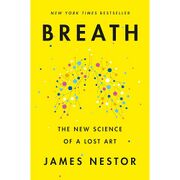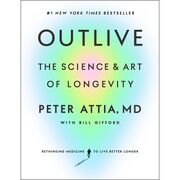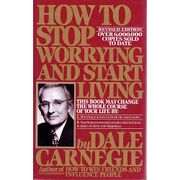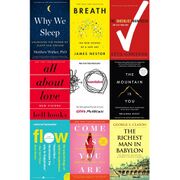Come as You Are
🍎 Healthy brain food
"Love is having. Desire is wanting. And you can want only what you don’t already have."
— Emily Nagoski, Come as You Are (2015)
Introduction
| Come as You Are | |
|---|---|
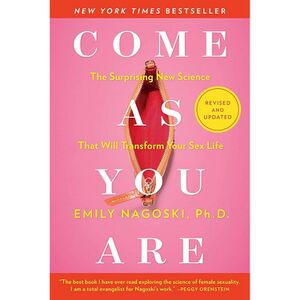 | |
| Full title | Come as You Are: The Surprising New Science That Will Transform Your Sex Life |
| Author | Emily Nagoski |
| Language | English |
| Subject | Women's sexuality; Sex education; Health & fitness |
| Genre | Nonfiction; Self-help |
| Publisher | Simon & Schuster Paperbacks |
Publication date | 3 March 2015 |
| Publication place | United States |
| Media type | Print (paperback); e-book; audiobook |
| Pages | 400 |
| ISBN | 978-1-4767-6210-4 |
| Goodreads rating | 4.3/5 (as of 6 November 2025) |
| Website | simonandschuster.com |
📘 Come as You Are is a nonfiction guide to women’s sexuality by sex educator Emily Nagoski, first published in the United States in 2015 and issued in a substantially revised trade paperback on 2 March 2021.[1][2][3] It popularizes the dual control model of sexual response—the balance of “accelerators and brakes” (excitation and inhibition)—and explains responsive desire and arousal non-concordance in a sex-positive, evidence-driven register.[4][5][2] The writing mixes research summaries, anecdotes, and exercises, and downloadable worksheets extend the book’s practical tools.[6][7] The revised edition is organized into four parts and nine main chapters; this outline follows the revised trade paperback.[2][8][9] The publisher promotes the title as a New York Times bestseller, and it has been widely covered by mainstream outlets since release, including WBUR and New York Magazine’s The Cut.[2][10][11]
Chapter summary
This outline follows the Simon & Schuster trade paperback edition, revised and updated (2 March 2021; ISBN 9781982165314).[2] Chapter titles and part structure per catalog/preview records.[12][8] First U.S. edition metadata: Simon & Schuster Paperbacks (2015), xi+400 pp.; ISBNs 9781476762104 (pbk.) and 9781476762098 (hc).[1][13]
I – The (Not-So-Basic) Basics
🧬 1 – Anatomy: No Two Alike. In 2005 at the Royal Melbourne Hospital, urologist Helen O’Connell synthesized modern imaging and dissection evidence to show the clitoris as a multiplanar structure with internal crura and vestibular bulbs, with only the glans visible externally.[14] A BJOG study the same year, measuring vulvas of fifty premenopausal women under general anesthesia, reported wide ranges across labial length, clitoral size, and distances between landmarks—evidence against a single “normal.”[15] A hands-on tour—mirror, light, and curiosity—aligns the map with the terrain, clarifies terms (glans, crura, bulbs), and reframes the hymen as tissue, not a moral test.
🎛️ 2 – The Dual Control Model: Your Sexual Personality. The Kinsey Institute's Bancroft and Janssen proposed the Dual Control Model (gas/brake), later operationalized for women via the SESII-W and subsequent SESII-W/M scales; psychometrics consistently resolve excitation and inhibition propensities that differ across individuals.[16][17] Practical prompts list “accelerators” (context, touch, words) and “brakes” (stress, self-judgment, threat) and encourage adjusting the ratio in real time.
💍 3 – Context: And the "One Ring" (to Rule Them All) in Your Emotional Brain. Context—safety, timing, meaning—changes arousal. Experiments linking chronic stress, cortisol, distraction, and lower genital arousal show attention load, not hormones per se, as the primary blocker; closing stress cycles and adding safety cues quiet the brake so relevant cues reach the accelerator.[18]
II – Sex In Context
🧠 4 – Emotional Context: Sex in a Monkey Brain. In stress-manipulation studies using vaginal photoplethysmography, women with higher stress show reduced genital arousal and more distraction; when models adjust for covariates, distraction predicts the drop in genital response.[19]
🌐 5 – Cultural Context: A Sex-Positive Life in a Sex-Negative World. The World Health Organization frames sexual health as well-being and a “positive and respectful approach” to sexuality, free of coercion and discrimination; the 2020 National Sex Education Standards add grade-level outcomes on consent, media literacy, and LGBTQIA+ inclusion.[20][21] Objectification theory explains how body surveillance drags attention out of the body and predicts more anxiety and less pleasure; countermeasures include self-compassion, consent skills, and environments that normalize diversity.[22]
III – Sex In Action
⚡ 6 – Arousal: Lubrication Is Not Causation. A 132-study meta-analysis (1969–2007; 2,505 women; 1,918 men) found much lower agreement between women’s genital and self-reported arousal (≈r=.26) than men’s (≈r=.66), showing that physiological response often diverges from felt desire or pleasure; consent lives in words and choices, not blood flow.[23]
💫 7 – Desire: Spontaneous, Responsive, and Magnificent. The book distinguishes spontaneous desire (out-of-the-blue wanting) from responsive desire (wanting that emerges from context and stimulation) and normalizes both; practical tools shift focus from “keeping the spark” to building cues that make sex wanted now (predictable time, protected space, aftercare, and meaning).[8][24]
🎉 8 – Orgasm: Pleasure Is the Measure. Nagoski centers pleasure—not performance metrics—as the unit of change; because arousal non-concordance is common, the safer rule is ongoing, enthusiastic participation and communication. Her podcast prelude and the revised text reiterate that “pleasure is the measure,” shifting attention to what feels good now rather than chasing outcomes.[25][26]
IV – Ecstasy For Everybody
🌱 9 – Love What’s True: The Ultimate Sex-Positive Context. The culminating theme ties skills together: define safety and meaning, de-load shame, and practice self-compassion so attention can stay with sensation. The WHO framework and objectification research align with this: positive, respectful contexts reduce threat appraisal and free attention for wanted, pleasurable stimulation.[27][28][8]
Background & reception
🖋️ Author & writing. Emily Nagoski is a sex educator with an MS in counseling and a PhD in health behavior (Indiana University), with clinical and research training at the Kinsey Institute; she previously served as director of wellness education at Smith College.[3][29][30] The book synthesizes contemporary sex science for general readers, centering context effects, the dual control model, and distinctions among arousal, desire, pleasure, and consent.[2] The dual control framework traces to work by John Bancroft and Erick Janssen and remains an active research area.[31] Reviewers noted the book’s friendly, accessible tone and clear visuals, emphasizing its “you-are-normal” message.[32] Practical tools are reinforced by official worksheets hosted on the author’s site.[33]
📈 Commercial reception. The first U.S. edition was published by Simon & Schuster Paperbacks in 2015 (400 pp.; ISBN 978-1-4767-6210-4), with library records confirming the bibliographic details; a revised and updated trade paperback followed on 2 March 2021 (400 pp.).[1][13][2] The publisher promotes the title as a New York Times bestseller.[2] International editions appeared with Scribe in 2015 for Australia and the UK markets.[34][35]
👍 Praise. In The Guardian, Van Badham praised the book’s merger of pop science and sexual self-help “in prose that’s not insufferably twee,” adding that it offers “hard facts on the science of arousal and desire” in a friendly way (27 April 2015).[36] WBUR (Boston’s NPR newsroom) highlighted the book’s myth-busting approach and predicted it would be a pivotal read for many (13 March 2015).[37] Salon’s interview with Nagoski called it a rare sex-advice book that “actually has it” — lasting value beyond quick fixes (6 March 2015).[38]
👎 Criticism. Even positive reviewers noted stylistic tics; The Guardian mentioned “a few too many gardening metaphors.”[39] Some reviewers observed that the book primarily addresses cisgender women, reflecting limits of available research on trans populations at the time; they argue that readers seeking broader LGBTQ+ coverage may find scope constraints.[40] Scholars also caution that evidence underpinning the dual control model—a framework the book popularizes—continues to evolve, with calls for further measurement refinement and population-diverse research.[41]
🌍 Impact & adoption. The book extended into an eight-part audio series, the Come As You Are podcast, announced for 16 November 2022 and released with early episodes in mid-November 2022 by Pushkin Industries/Madison Wells.[42][43][44] It appears on higher-education syllabi and resource lists, including Wesleyan University’s Summer 2024 graduate seminar materials, the University of Florida’s Spring 2025 “Sexuality in Mental Health” course, and Western Washington University’s 2024 campus consent guide.[45][46][47]
Related content & more
YouTube videos
CapSach articles
Enjoyed this page?
📚If this page Come as You Are inspired or helped you today, a small coffee helps us keep creating and sharing more. Your support truly matters.👏
References
- ↑ 1.0 1.1 1.2 "Come as you are : the surprising new science that will transform your sex life". WorldCat. OCLC. Retrieved 19 October 2025.
- ↑ 2.0 2.1 2.2 2.3 2.4 2.5 2.6 2.7 "Come As You Are: Revised and Updated". Simon & Schuster. Simon & Schuster. 2 March 2021. Retrieved 19 October 2025.
- ↑ 3.0 3.1 "Emily Nagoski". Simon & Schuster. Simon & Schuster. Retrieved 19 October 2025.
- ↑ "Why Are Young People Having So Little Sex?". The Atlantic. 15 December 2018. Retrieved 19 October 2025.
- ↑ "'You're normal!' is science's battle cry in the fight for sexual liberation". The Guardian. 27 April 2015. Retrieved 19 October 2025.
- ↑ "'You're normal!' is science's battle cry in the fight for sexual liberation". The Guardian. 27 April 2015. Retrieved 19 October 2025.
- ↑ "Come As You Are Worksheets". EmilyNagoski.com. Emily Nagoski. Retrieved 19 October 2025.
- ↑ 8.0 8.1 8.2 8.3 "Come As You Are: Revised and Updated — Contents". Google Books. Google. 2 March 2021. Retrieved 6 November 2025.
- ↑ "Come As You Are (Revised and Updated) — Table of contents". Perlego. Perlego. Retrieved 6 November 2025.
- ↑ Goldberg, Carey (13 March 2015). "'Come As You Are': Book Explores Old Lies And New Science On Women And Sex". WBUR News. Retrieved 19 October 2025.
- ↑ "The Way You Understand Your Sex Drive Is Wrong". The Cut. New York Magazine. 8 April 2015. Retrieved 19 October 2025.
- ↑ "Come as you are: the surprising new science that will transform your sex life — revised & updated". Colorado Mountain College Library Catalog. Colorado Mountain College. Retrieved 19 October 2025.
- ↑ 13.0 13.1 "Come as you are : the surprising new science that will transform your sex life". Contra Costa County Library Catalog. Contra Costa County Library. Retrieved 19 October 2025.
- ↑ O'Connell, Helen E.; Sanjeevan, Kalavampara V.; Hutson, John M. (October 2005). "Anatomy of the clitoris". The Journal of Urology. 174 (4 Pt 1): 1189–1195. doi:10.1097/01.ju.0000173639.38898.cd. PMID 16145367. Retrieved 6 November 2025.
- ↑ Lloyd, Jillian; Crouch, Naomi S.; Minto, Catherine L.; Liao, Lih-Mei; Creighton, Sarah M. (May 2005). "Female genital appearance: "normality" unfolds". BJOG: An International Journal of Obstetrics & Gynaecology. 112 (5): 643–646. doi:10.1111/j.1471-0528.2004.00517.x. PMID 15842291. Retrieved 6 November 2025.
- ↑ Bancroft, John; Janssen, Erick (2000). "The dual control model of male sexual response: a theoretical approach to centrally mediated erectile dysfunction". Neuroscience & Biobehavioral Reviews. 24 (5): 571–579. doi:10.1016/S0149-7634(00)00024-5. Retrieved 19 October 2025.
- ↑ Velten, Julia; Scholten, Saskia; Margraf, Jürgen (2018). "Psychometric properties of the Sexual Excitation/Sexual Inhibition Inventory for Women and Men (SESII-W/M) and the SIS/SES-SF". PLOS ONE. 13 (3): e0193080. doi:10.1371/journal.pone.0193080. Retrieved 6 November 2025.
{{cite journal}}: CS1 maint: article number as page number (link) CS1 maint: unflagged free DOI (link) - ↑ Hamilton, Lisa Dawn; Meston, Cindy M. (2013). "Chronic Stress and Sexual Function in Women". The Journal of Sexual Medicine. 10 (10): 2443–2454. doi:10.1111/jsm.12249. PMC 4199300. PMID 23863044. Retrieved 6 November 2025.
- ↑ Hamilton, Lisa Dawn; Meston, Cindy M. (2013). "Chronic Stress and Sexual Function in Women". The Journal of Sexual Medicine. 10 (10): 2443–2454. doi:10.1111/jsm.12249. PMC 4199300. PMID 23863044. Retrieved 6 November 2025.
- ↑ "Defining sexual health". World Health Organization. WHO. Retrieved 6 November 2025.
- ↑ "National Sex Education Standards: Core Content and Skills, K–12 (Second Edition)" (PDF). Advocates for Youth. FoSE/Advocates for Youth. 29 May 2020. Retrieved 6 November 2025.
- ↑ Fredrickson, Barbara L.; Roberts, Tomi-Ann (1997). "Objectification Theory: Toward Understanding Women's Lived Experiences and Mental Health Risks". Psychology of Women Quarterly. 21 (2): 173–206. doi:10.1111/j.1471-6402.1997.tb00108.x. Retrieved 6 November 2025.
- ↑ Chivers, Meredith L.; Seto, Michael C.; Blanchard, Ray; Lalumière, Martin L.; Lentz, Eric M.; Bailey, J. Michael (2010). "Agreement of Self-Reported and Genital Measures of Sexual Arousal in Men and Women: A Meta-Analysis". Archives of Sexual Behavior. 39 (1): 5–56. doi:10.1007/s10508-009-9556-9. PMID 20049519. Retrieved 6 November 2025.
- ↑ "How Desire Actually Works". Apple Podcasts. Apple Inc. 30 November 2022. Retrieved 6 November 2025.
- ↑ "CAYA E1 Transcript (Prelude): Pleasure is the measure" (PDF). Pushkin Industries. Pushkin Industries. 15 November 2022. Retrieved 6 November 2025.
- ↑ Chivers, Meredith L. (2010). "Agreement of Self-Reported and Genital Measures of Sexual Arousal in Men and Women: A Meta-Analysis". Archives of Sexual Behavior. 39 (1): 5–56. doi:10.1007/s10508-009-9556-9. PMID 20049519. Retrieved 6 November 2025.
- ↑ "Defining sexual health". World Health Organization. WHO. Retrieved 6 November 2025.
- ↑ Fredrickson, Barbara L.; Roberts, Tomi-Ann (1997). "Objectification Theory: Toward Understanding Women's Lived Experiences and Mental Health Risks". Psychology of Women Quarterly. 21 (2): 173–206. doi:10.1111/j.1471-6402.1997.tb00108.x. Retrieved 6 November 2025.
- ↑ "about emily — Emily Nagoski, Ph.D." EmilyNagoski.com. Emily Nagoski. Retrieved 19 October 2025.
- ↑ "Archive of 2008–09 People News". Smith College. Smith College. Retrieved 19 October 2025.
- ↑ Janssen, Erick; Bancroft, John (2023). "The Dual Control Model of Sexual Response: A Scoping Review, 2009–2022". Annual Review of Sex Research (Society for the Scientific Study of Sexuality): 1–27. Retrieved 19 October 2025.
- ↑ "'You're normal!' is science's battle cry in the fight for sexual liberation". The Guardian. 27 April 2015. Retrieved 19 October 2025.
- ↑ "Come As You Are Worksheets". EmilyNagoski.com. Emily Nagoski. Retrieved 19 October 2025.
- ↑ "Come as You Are". Scribe Publications (AU). Scribe Publications. Retrieved 6 November 2025.
- ↑ "Come as You Are". Scribe Publications (UK). Scribe Publications. Retrieved 6 November 2025.
- ↑ "'You're normal!' is science's battle cry in the fight for sexual liberation". The Guardian. 27 April 2015. Retrieved 19 October 2025.
- ↑ Goldberg, Carey (13 March 2015). "'Come As You Are': Book Explores Old Lies And New Science On Women And Sex". WBUR News. Retrieved 19 October 2025.
- ↑ Clark-Flory, Tracy (6 March 2015). "Forget female Viagra: This new book dismantles stubborn myths about women and sexual desire". Salon. Retrieved 19 October 2025.
- ↑ "'You're normal!' is science's battle cry in the fight for sexual liberation". The Guardian. 27 April 2015. Retrieved 19 October 2025.
- ↑ "Come As You Are by Emily Nagoski". Smart Bitches, Trashy Books. Smart Bitches, Trashy Books LLC. 23 June 2023. Retrieved 19 October 2025.
- ↑ Janssen, Erick; Bancroft, John (2023). "The Dual Control Model of Sexual Response: A Scoping Review, 2009–2022". Annual Review of Sex Research (Society for the Scientific Study of Sexuality): 1–27. Retrieved 19 October 2025.
- ↑ "'Come as You Are' Podcast Set From Madison Wells, Pushkin". The Hollywood Reporter. 2 November 2022. Retrieved 6 November 2025.
- ↑ "Come As You Are — Podcast on Apple Podcasts (show page)". Apple Podcasts. Apple Inc. 16 November 2022. Retrieved 6 November 2025.
- ↑ "CAYA E2 Transcript" (PDF). Pushkin Industries. Pushkin Industries. 16 November 2022. Retrieved 6 November 2025.
- ↑ "SCIE 601 (Summer 2024) — Syllabus sample readings" (PDF). Wesleyan University. Wesleyan University. Retrieved 19 October 2025.
- ↑ "Sexuality in Mental Health — Spring 2025 Syllabus". University of Florida. University of Florida. Retrieved 19 October 2025.
- ↑ "The Consent Guide Book" (PDF). Western Washington University. Western Washington University. April 2024. Retrieved 19 October 2025.


